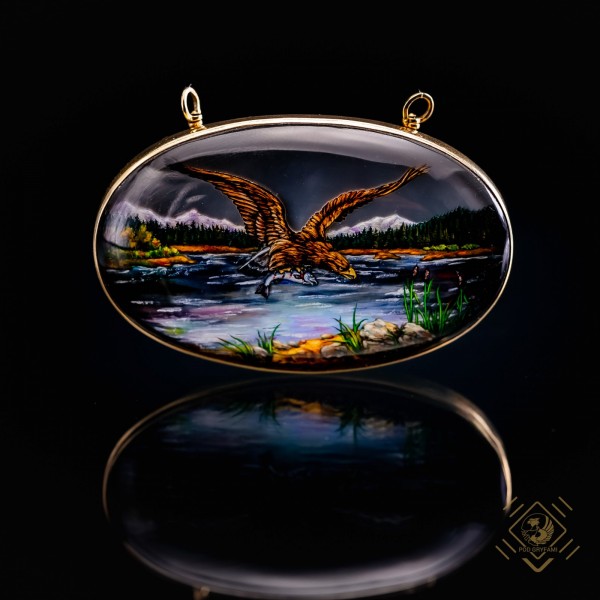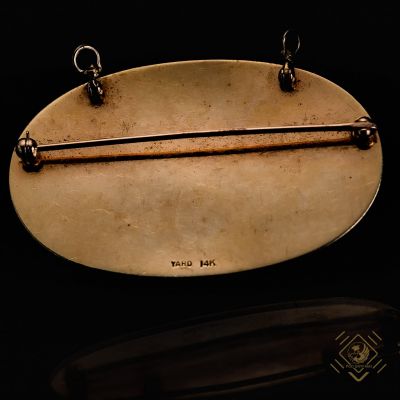Raymond Yard Brooch
Price range: 



 (10 000 zł - 25 000 zł)
(10 000 zł - 25 000 zł)
Raymond Yard
This brooch was created in 1925 and is an excellent example of the use of Essex crystal technology. A majestic eagle hovering over a shimmering sheet of water holds a fish in its clutches. The whole piece is framed in 14 carat gold. This beautiful miniature work of art can be used as a pendant or a brooch for a woman or a spectacular tie clip for a man. Certainly, it would also serve as a decoration for any miniature collection.
Raymond C. Yard (1885 - 1964) as a thirteen year old boy was employed as a messenger by William Marcus in one of the best jewelry companies in New York, Marcus&Co. Over the next 24 years, he gained a thorough education in all aspects of jewelry trade, and became one of the best jewelry masters in New York and a leading expert in pearls. In 1922 he was encouraged by John D. Rockefeller Jr., who supported him financially, to open his own studio and showroom in New York on 5th Avenue. In a short time he became a favorite jeweler of the distinguished families of American financial tycoons. Yard's clientele included such names as the aforementioned John D. Rockefeller and Woolworth, Flagler, DuPont, Harriman and Vanderbilt, as well as film stars Joan Crawford and Douglas Fairbanks. Discreet, patient and extremely precise, the goldsmith fulfilled the most sophisticated desires of his clients. Obtaining the highest quality materials, he repaired and processed old jewels and successfully designed new ones according to the sophisticated designs of his invention. In 1958, after retiring, Yard handed over his legacy to his long-time collaborators: Glen McQuaker, Donald Bartow and Robert Gibson, whom he made president of the company. In 1989, the company was taken over by Gibson's son, who has been successfully operating in the world of luxury jewels to this day. Yard used diamonds and precious stones in his projects, but did not hesitate to use more complex technologies. He became famous for his Art Deco design, especially beautiful jewels created in the mid-1920s with the use of the Essex Crystal.
Essex Crystal
Essex Crystals took their name from the name of William Essex (~ 1784-1869), a famous creator of enameled miniatures from the Victorian and Edwardinian periods. This technique required perfect precision, patience and great artistic talent. On the flat side of the crystal, a pattern was carved using various types of soft steel tools, as many as 250 tools, diamond powder and oil, which was then covered with watercolor or enamel. Gold foil and pickled pearl mass were used as backgrounds to enhance the three-dimensional effect. Essex crystal, also called reverse intaglio, gained popularity between 1860 and 1930. During this period, unique works of jewelry art were created using this technique. The creators were inspired by four main categories: animals, flowers, birds and marine motifs.
Details
| Country of Origin: | USA |
| Artist: | Raymond Yard |
| Year: | 1925 |
| Era: | (1915-1935) Art Deco |
| Technique: | Essex Crystal, enamel, pearl |
| Metal: | Au |
| Fineness: | 14k |
| Weight: | 45.84g |
| Remarks: | Yard's signature is engraved on the reverse side, by the lower edge |
| Length: | 5.9cm |
| Width: | 3.6cm |
| For: | Unisex |





